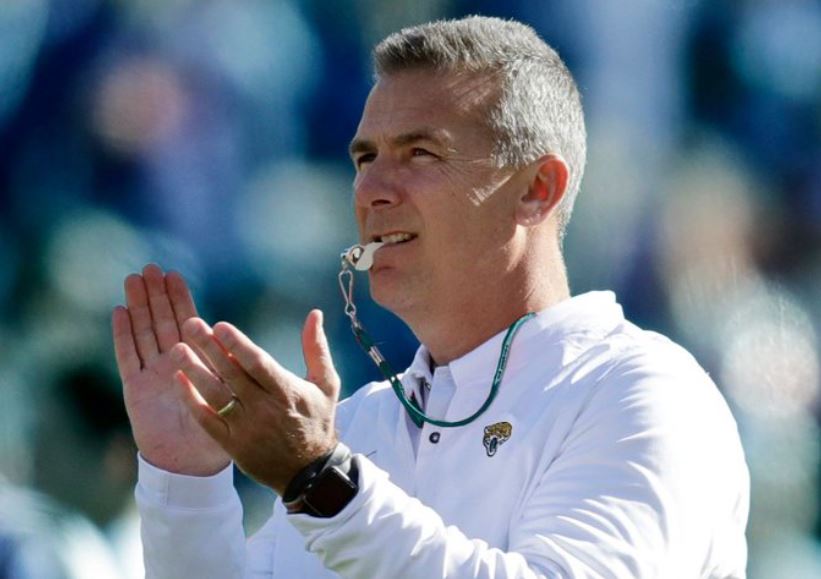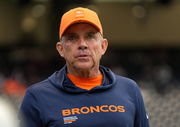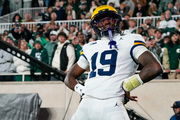

“Why should we have to go to class if we came here to play football? We ain’t come to play school, classes are pointless.” Buckeye Nation would remember this statement, which a relatively unknown QB at the time, Cardale Jones, tweeted in 2012. The statement, as expected, was controversial, but more importantly, it clashed with the 10-80-10 philosophy Urban Meyer was championing at Ohio State. Jones later led OSU to its 2014 national title in one of the most unexpected individual Cinderella stories in college football. But more than that, little did Meyer know that Jones’ words would foreshadow a harsh reality in today’s CFB world. The very reality that, according to Meyer, might have contributed to his retirement.
Watch What’s Trending Now!
Urban Meyer’s arrival at Ohio State came when OSU was reeling from the penalties of the ‘tattogate’ scandal and a first-ever losing season (2011) since 1988 under Luke Fickell. But Meyer came in with his spread offense and shook the Big 10 by its core, finishing with a perfect 12-win season in 2012, his first year. It was a statement of better times to come as Meyer later etched history by going 7-0 against the ‘team up north’ as OSU supporters like to call Michigan, and won the 2014 national title with a third-string QB (Cardale Jones). However, now, Meyer feels that, courtesy of the NIL and revenue sharing, the feats are far more difficult to replicate, as he declared, “I’m done” with coaching.
The OSU legend appeared on the 9th September podcast episode of ‘Global Billionaire Rainmakers’ and talked about his OSU tenure and his coaching mantra. Meyer specifically outlined his 10-80-10 rule, which helped him excel at OSU and turn his “ordinary players” into leaders. However, when co-host Marcy Nelson asked if implementing the 10-80-10 rule was possible in the current environment dominated by “earning cash” by the players, Meyer was out of words for a moment.
ADVERTISEMENT
“That’s a great question….I don’t have the answer to that. I made a decision about four years ago that I’m done, and I am done. I see what’s happening, and the game has never been stronger in college football as far as a product on the field. But I worry about the residual damage when everybody, including 17-18-year-olds, thinks about that? When their primary focus is money,” remarked Meyer. Moreover, the former OSU head coach outlined how his tenure without the NIL and revenue-sharing era was starkly different from what is happening right now in college football.
View this post on Instagram
“I grew up in an era where the primary focus when you’re a 17-and 18-year-old is shut your mouth and learn from your elders and respect authority and get great grades, and learn how to become an adult. I’m not sure that’s what it is now. Now I’m seeing 17- 18-year-olds who have agents and handlers. Everybody’s worrying about this money, that money. I’m thinking that there’s a chance that money is gone when you’re 23. What do you do then?” said Meyer. Despite widespread discussion of NIL, the actual consequences at the grassroots level remain largely under-addressed.
ADVERTISEMENT
Just a few years before Urban Meyer arrived in 2012 at Ohio State, the team’s players were accused of exchanging “team memorabilia” for “tattoos.” This was, of course, prohibited by the NCAA bylaws, and when the news broke out, the NCAA came out with a postseason ban for OSU in 2012. That post-season ban was the primary reason why, despite finishing with a perfect season in 2012, the Buckeyes didn’t make it to the championship game. However, in the NIL era, such “exchanges” are now the norm, with players like Arch Manning, Bryce Underwood, Carson Beck, Nico Iamaleava, and Jeremiah Smith earning multimillion-dollar deals.
ADVERTISEMENT
Urban Meyer outlines why his 10-80-10 coaching philosophy won’t work in CFB now
Urban Meyer’s 10-80-10 that he talked about revolved around putting his players in three major categories. The first 10% players in any squad would be “elite” and would need little to no push for excellence, the next 80% players would be the ordinary players, talented and hardworking, but may need some extra inspiration to succeed. Lastly, the last 10% players, according to Meyer, would be the individuals whom a coach “wouldn’t want on their team” as they likely would be undisciplined and disinterested. Now, for any team to win, or any organization to succeed, a balance has to be maintained among these three individuals.
“If you have a football team, you have too many of those guys, you’re going to lose a lot of games and probably eventually get fired….So, you got 10% elite, 80% average, and then 10% that you just kind of got to move on from. If you’re running a business or running a team,” said Meyer. And for a successful implementation of the rule, a team must “empower” the elite 10% athletes, according to Meyer, who would go on and push the rest of the 80% into the “elite” bracket. “You use the elite to build the power, pull the average up to the elite,” said Meyer. But this is something that won’t be possible in today’s scenario.
Top Stories
LIV Golf Braces for Another Possible Exit in Wake of Brooks Koepka Departure

Sean Payton Announces Retirement Plans as Broncos HC Demands Improvement From Bo Nix & Co. Before Playoffs

Greg Biffle’s $4M Prized Possession Goes Up for Sale After Tragic Crash, Leaving NASCAR Fans Heartbroken

Biff Poggi All But Confirms Bryce Underwood’s Michigan Future After Announcing His Own Departure

‘Fighting for His Life’: ESPN Confirms Kirk Herbstreit’s Silent Struggles at College GameDay

Rory McIlroy Makes Feelings Clear on Bryson DeChambeau’s PGA Tour Return: ‘Have Lost…’

Let’s say a player earns $12 million NIL money, despite not playing a single game of college football, and his regression starts quite early (say week 2 of the season). And it turns out that the player who might have achieved big went down because he started putting his importance way above the team. The guy would surely have earned $12 million, but surviving the world after college football would be extremely difficult. This is something even former UNC head coach Mack Brown had raised and pointed to low graduation rates for athletes.
ADVERTISEMENT
Meyer might have left college football for good, but it isn’t about NIL or revenue sharing. It’s truly about the ‘Wild-Wild-West’ that college football has lately become. Maybe 2014 then was the last time for someone like Cardale Jones to rise from being a third-string QB to lead the natty run, because what he said in 2012 seems to be developing into reality now!!
ADVERTISEMENT
ADVERTISEMENT
ADVERTISEMENT

